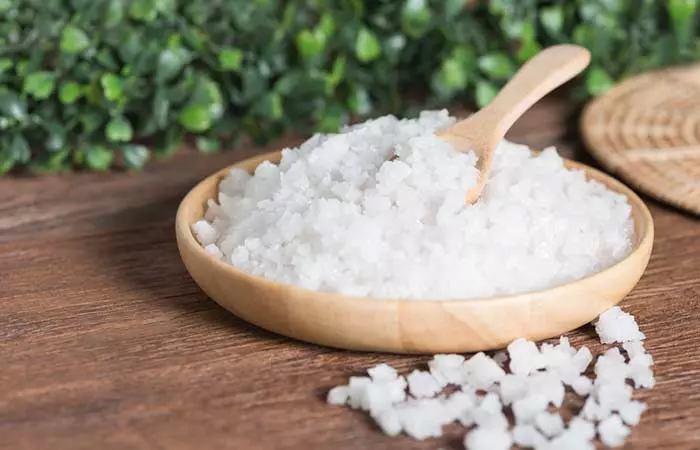How To Exfoliate Dead Skin At Home
How To Remove Dead Skin From The Face And Body
1. Brown Sugar
You Will Need
1 tablespoon brown sugar 1 teaspoon almond oil OR coconut oil
What You Have To Do
Increase the quantities of the ingredients to use this on your body.
How Often You Should Do This
Repeat this once or twice a week.
Why This Works
Raw sugar works best to exfoliate the dead skin on the face and the body, as its texture is coarser and it can remove the dead skin cells with the friction it generates when scrubbed on the skin. SHomemade sugar scrubs are gentler on the skin, and are less drying, and abrasive (1).
2. Baking Soda
You Will Need
1 tablespoon baking soda 1 vitamin E capsule Water
What You Have To Do
How Often You Should Do This
Do this once every week.
Why This Works
The fine baking soda granules can easily remove the dead skin cells from your facial skin. Its alkalinity will help to dislodge the skin cells so that they can be easily shed off. Baking soda may also help you achieve an even skin tone as it removes dead skin cells and keeps your pores clean.
3. Sugar And Honey
You Will Need
1 tablespoon sugar 1 teaspoon raw honey
What You Have To Do
How Often You Should Do This
Use this simple scrub 1-2 times a week.
Why This Works
This is one of the best homemade body scrubs that you can prepare easily. Both brown and white forms of sugar can help to exfoliate the skin. The honey in this mixture will help moisturize your skin and reverse the oxidative damage (2). Use this remedy to exfoliate dead skin cells on the arms and even other parts of the body. Ona Lefenyo, a natural hair and lifestyle vlogger, shared her experience of using a honey and sugar scrub for her bumpy skin. She said, “Listen, I am not overreacting or anything, but my face is so smooth (i)!” She further added that her skin felt soft and breathable and all the little bumps were gone.
4. Epsom Salt
You Will Need
1 cup Epsom salt 1 cup coconut oil 10-12 drops lavender oil (optional)
What You Have To Do
How Often You Should Do This
Use this scrub once a week to exfoliate the dead skin on the body.
Why This Works
The salt granules remove the dead skin when scrubbed gently on the skin. Epsom salt is considered a wonderful detoxifying and pH-balancing agent. It may also exfoliate and restore damaged skin.
5. Apple Cider Vinegar
You Will Need
1 teaspoon apple cider vinegar 1 teaspoon water Cotton ball
What You Have To Do
To exfoliate dead skin on your feet, add half a cup of ACV to a tub filled with some water and soak your feet in this for 10-12 minutes.
How Often You Should Do This
Repeat this once a week.
Why This Works
Vinegar may maintain the pH balance of skin and prevent it from becoming too dry or oily (3). It also has antibacterial and antifungal properties that keep the skin infection-free. Diluted ACV may also be used to exfoliate dead skin on the scalp.
Caution
Do not use this remedy if you have sensitive skin as the vinegar can sting.
6. Toothbrush
You Will Need
Lip balm Toothbrush
What You Have To Do
How Often You Should Do This
Use this remedy twice a week.
Why This Works
This is one of the easiest remedies to exfoliate the lips. The lip balm softens the dead skin present on the lips’ surface. The bristles of the toothbrush can help dislodge this and give you smooth and plump lips.
7. Coffee Grounds
You Will Need
2-3 tablespoons coffee grounds 1 tablespoon olive oil OR coconut oil Water
What You Have To Do
How Often You Should Do This
Do this coffee ground exfoliation once every week.
Why This Works
Exfoliate the dead skin on your legs with this and see them shine with hydration. This scrub can also be used on the face but very gentle scrubbing movements should be used. Like the other scrubs, the coarseness of the coffee grounds removes dead skin cells. Coffee contains caffeine which awakens the skin by improving circulation. Use this scrub on your thighs, buttocks, and tummy to get rid of cellulite too. Caffeine prevents the accumulation of fat beneath the skin – a wonderful additional benefit (4)!
8. Olive Oil
You Will Need
2-3 olive pits 2 tablespoons olive oil
What You Have To Do
How Often You Should Do This
Repeat this once every 4-5 days.
Why This Works
While the ground pits exfoliate your skin, olive oil will nourish with a wonderful combination of fatty acids and essential nutrients (5).
9. Pumice Stone
You Will Need
Water A tub Pumice stone
What You Have To Do
How Often You Should Do This
Repeat this as and when required.
Why This Works
To remove dead skin from the skin, that pumice stone lying in your bathroom is all you need. Once the dead skin has softened because of soaking in the water, it can be easily scrubbed off.
10. Oatmeal
You Will Need
2 teaspoons ground oatmeal Water
What You Have To Do
This can be used on the rest of the body as well.
How Often You Should Do This
Repeat this once or twice a week.
Why This Works
Oatmeal is an excellent choice for a homemade exfoliator, especially for the face. It softens the dead skin so that it can be gotten rid of easily. It also moisturizes the skin and reduces any inflammations that may be present (6). Use this to exfoliate the skin before shaving to make the process smoother and faster. The last step to follow after exfoliating your skin is to moisturize the skin. Follow all the remedies mentioned above with a moisturizer matching your skin type. This will ensure adequate skin hydration. Now you know why and how to exfoliate. But if the above remedies fail, you can opt for chemical exfoliants for the effective removal of dead skin cells. Find out more in the next section.
Why Exfoliate?
To understand this, you need to know why exfoliation is essential for a healthy looking skin. Human skin is constantly regenerating itself. Old cells on the top layer of the skin die and are replaced by new cells that form in the lower layer or the dermis, the basal layer of the epidermis. As we age, however, our skin’s natural regenerative powers deteriorate. Exfoliation is the process by which we can help our skin’s regeneration process by removing dead skin cells and making way for new ones. Dr. Nadir Qazi, a board-certified cosmetic physician, says, “Exfoliating removes excessive dead skin cells while softening and rejuvenating the skin and encouraging collagen production. Skin health is all about balance and paying attention to its changes.” However, he also warns about over-exfoliation. He adds, “Over-exfoliation can cause this barrier to deplete and allow the new skin to become exposed. This can lead to chafing and raw, reddened, dry skin. However, when the dead skin cells are not removed, they can clog pores leading to acne, blackheads, and even ingrown hairs.” In the exfoliation process, we use products that help remove the old skin and reveal the new skin underneath. There are, primarily, two ways by which we can exfoliate our skin – physical and chemical exfoliation. Physical exfoliation involves using a body scrub. There is a way to conduct this procedure, so it is better you get well-versed in how to use a body scrub, as the wrong way can harm your skin. Chemical exfoliation or chemical peels use products that contain enzymes which can help dislodge the dead cells from the skin by their chemical action. Other skin treatments involving the removal of the upper skin layer are dermabrasion and microdermabrasion.. No matter which process of exfoliation you opt for, it will leave your skin refreshed and rejuvenated. Here are some exfoliation remedies that you can make at home and slough off that unwanted dead skin. You no longer have to make a trip to a spa for a fresh looking, happy skin.
Chemical Exfoliants For Removing Dead Skin
Glycolic acid and salicylic acid can help remove dead skin cells. Incorporating them into your skin care routine can also help you unclog your pores and improve your overall skin tone and texture. You can buy weaker formulas as over-the-counter products, while stronger formulas are used by dermatologists in chemical peels. These acids break the bonds holding the skin cells together, which shed eventually to reveal regenerated skin (7). Hence, seek professional advice to understand which option is suitable for you. You may also use natural ingredients like lemon and yogurt for chemical exfoliation. Lemon contains citric acid, while yogurt has lactic acid. These natural acids help exfoliate the top layer of dead skin (8) (9). However, remember to always perform a patch test before using them to avoid any irritation, especially if you have sensitive skin. Some tips to keep in mind during exfoliation
Tips To Remember
Always be gentle on your skin, taking care not to strip your skin of the natural oils and lipids, as it may otherwise cause skin aging. Always choose gentle scrubs and skin exfoliating tools. Fix a proper skin care routine. Do not exfoliate daily. The frequency of exfoliation should be determined by your skin type and needs. Dry skin and mature skin should be exfoliated not more than twice a week and products such as creams or serums that are used should be moisturizing. An oil-based scrub would be the best. Oily skin and combination skin can be exfoliated thrice a week, but no more than that. Normal skin can be exfoliated twice a week or as necessary. When exfoliating, use gentle hands or skin brushes in circular and/or upward motions which work best. Such movements will keep your skin firm in the long run.
Is removing dead skin painful? Dr. Qazi says, “Removing dead skin cells shouldn’t be painful. If it is painful, the chances are that you are using the wrong exfoliant. An abrasive exfoliator should be avoided as they can not only be painful to use but can lead to microtears in the skin. The concentrations of the exfoliants can also be controlled to remove dead skin without pain.” Does washing your face remove dead skin? According to Dr. Qazi, “Washing the face can remove some already loosened dead skin cells. You will get better results by using a chemical exfoliant in combination with a gentle cleanser. In contrast, a face wash with stronger cleansing agents and surfactants may irritate and damage the skin.” Why does my face have so much dead skin? Skin dryness and a lack of regular exfoliation routine can lead to a buildup of dead skin on the face. What does dead skin look like? Dead skin looks flaky, tough, and dry on the surface of the skin. What causes dead skin? It is natural for skin cells to die out and new ones to replace old and dead skin. However, a lack of moisture in skin cells can speed up or aggravate the process of skin cell death, leading to dead skin buildup. What are the signs of over-exfoliation? Signs of over-exfoliation include irritation, redness, peeling, burning sensation, and inflammation. You may also experience acne breakouts.
Illustration: How To Remove Dead Skin Naturally?
Are you looking for a simple and effective way to remove dead skin cells from your body? This informative video provides step-by-step instructions and tips for achieving smooth, glowing skin. Check it out!


















